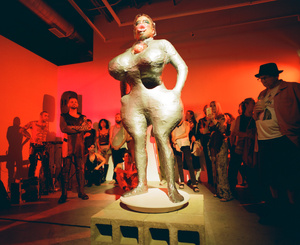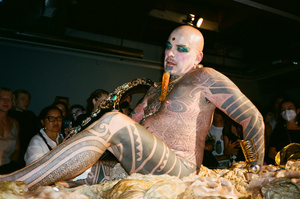Willendorf with Ron Athey and Hermes Pittakos


















About


















About
August 17 & 24, 2024
Murmurs Gallery is honored to present Willendorf a performance by Ron Athey and Hermes Pittakos. For the creation of Willendorf, Athey invited his longtime collaborator, friend, and sculptor, Hermes Pittakos from Athens, to revisit and re-contextualize The Trojan Whore, a performance Athey staged in 1996 in memoriam of the late artist Leigh Bowery. For the past two weeks, Murmurs Gallery has functioned as a residency where Athey and Pittakos have been creating new sets, prosthetics, and costumes for the performance using handcrafted silicone, plaster and other materials. These art objects will be on view as an installation in the gallery during the interim between the performances from August 17th to 24th.
Willendorf follows a two-act structure, beginning with the redux of Trojan Whore, where Athey will don a version of the suit from 1996 performance which is inspired by the voluptuous shape of the Paleolithic fertility figurine the Venus of Willendorf. Using gauze to wrap his body until all physical movement is restricted, Trojan Whore infuses a bigger-than-life fertility goddess with quintessential Atheyian endurance aesthetics to offer up new meaning as totem defining a non-reproductive futurity.
Act II of Willendorf moves into horizontal territory– Athey will take his repose in a vitrice of silicone viscera sculpted by Pittakos. Lying embedded in an extension of bodily material and wearing jewel-encrusted armor, Athey conjures the 2nd Century Saint Hyacinth of Caesarea, a chamberlain of Emperor Trajan who was martyred, aged 12, after being starved to death for his Christian faith. Hyacinth’s bejeweled skeleton is one example of the catacomb saints, whose bodies served as holy relics to personify the glory of the afterlife to 16th and 17th Century Catholics. Members of the audience are invited up to add treasures on top of Athey’s body, participating in a ritual that intervenes on tradition, an act of counter-morbidity against nihilism. Through the collective yet transgressive act of touching, the artist’s body is conferred on as a site of resistance, power, and revitalization.
Murmurs Gallery is honored to present Willendorf a performance by Ron Athey and Hermes Pittakos. For the creation of Willendorf, Athey invited his longtime collaborator, friend, and sculptor, Hermes Pittakos from Athens, to revisit and re-contextualize The Trojan Whore, a performance Athey staged in 1996 in memoriam of the late artist Leigh Bowery. For the past two weeks, Murmurs Gallery has functioned as a residency where Athey and Pittakos have been creating new sets, prosthetics, and costumes for the performance using handcrafted silicone, plaster and other materials. These art objects will be on view as an installation in the gallery during the interim between the performances from August 17th to 24th.
Willendorf follows a two-act structure, beginning with the redux of Trojan Whore, where Athey will don a version of the suit from 1996 performance which is inspired by the voluptuous shape of the Paleolithic fertility figurine the Venus of Willendorf. Using gauze to wrap his body until all physical movement is restricted, Trojan Whore infuses a bigger-than-life fertility goddess with quintessential Atheyian endurance aesthetics to offer up new meaning as totem defining a non-reproductive futurity.
Act II of Willendorf moves into horizontal territory– Athey will take his repose in a vitrice of silicone viscera sculpted by Pittakos. Lying embedded in an extension of bodily material and wearing jewel-encrusted armor, Athey conjures the 2nd Century Saint Hyacinth of Caesarea, a chamberlain of Emperor Trajan who was martyred, aged 12, after being starved to death for his Christian faith. Hyacinth’s bejeweled skeleton is one example of the catacomb saints, whose bodies served as holy relics to personify the glory of the afterlife to 16th and 17th Century Catholics. Members of the audience are invited up to add treasures on top of Athey’s body, participating in a ritual that intervenes on tradition, an act of counter-morbidity against nihilism. Through the collective yet transgressive act of touching, the artist’s body is conferred on as a site of resistance, power, and revitalization.
Photos by Dillon Sachs

